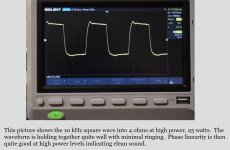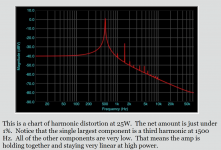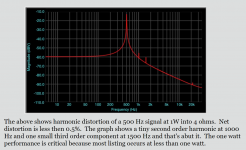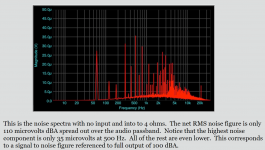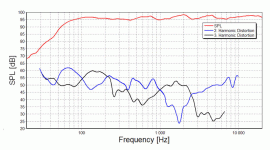For those of us who are still learning, amplifier Scope Measurements can still be baffling.
This is especially highlighted when one is considering a new purchase - and one is not able to first audition said amp. Such is living in New Zealand.
I figured it would be better to share these measurements here and gain some expert opinions from those of you with greater knowledge and experience - before moving forward.
So here we have a recently released, tubed stereo Muscle Amp, offered in Kitset format by a very well respected amp designer.
Equipped with SS rectification, this bad boy is wired for PUSH-PULL, TRIODE operation with two KT120 tubes per channel; said to deliver 35W into 4R or 2R.
Specifications:
Power: 35W per channel into 4 or 2 ohms.
THD: less than 1% up to full power.
Power bandwith: +/- 1 dB from 30 Hz to 30 kHz .
Noise: 110 microvolts A weighted, or 100 dBA referenced to full power.
Output impedance: 2.5 ohms
Gain: 28 dB or 400 mV for full power. Can be driven by passive preamps.
Input impedance: 100 kOhms.
Dimensions: W17" x D11" x H8.5"
Weight: 26 lbs.
Power consumption: 165 watts at idle.
Voltage: 115-120V or 230-240V, 50-60 Hz.
Tube compliment: four- KT120, two- ECC99, two- 12AU7
(Measurement pics below...)
Most of our speakers have a minimum 4-ohm dip amd are between 87dB-90dB sensitive, so power levels should be more than adequate.
How do these measurements look to you? Based upon what is presented here, would YOU buy this amp?
This is especially highlighted when one is considering a new purchase - and one is not able to first audition said amp. Such is living in New Zealand.
I figured it would be better to share these measurements here and gain some expert opinions from those of you with greater knowledge and experience - before moving forward.
So here we have a recently released, tubed stereo Muscle Amp, offered in Kitset format by a very well respected amp designer.
Equipped with SS rectification, this bad boy is wired for PUSH-PULL, TRIODE operation with two KT120 tubes per channel; said to deliver 35W into 4R or 2R.
Specifications:
Power: 35W per channel into 4 or 2 ohms.
THD: less than 1% up to full power.
Power bandwith: +/- 1 dB from 30 Hz to 30 kHz .
Noise: 110 microvolts A weighted, or 100 dBA referenced to full power.
Output impedance: 2.5 ohms
Gain: 28 dB or 400 mV for full power. Can be driven by passive preamps.
Input impedance: 100 kOhms.
Dimensions: W17" x D11" x H8.5"
Weight: 26 lbs.
Power consumption: 165 watts at idle.
Voltage: 115-120V or 230-240V, 50-60 Hz.
Tube compliment: four- KT120, two- ECC99, two- 12AU7
(Measurement pics below...)
Most of our speakers have a minimum 4-ohm dip amd are between 87dB-90dB sensitive, so power levels should be more than adequate.
How do these measurements look to you? Based upon what is presented here, would YOU buy this amp?
Attachments
Last edited:
What is the price? You should also see the square wave response at low frequencies, 50Hz etc.
Last edited:
Looks pretty good, except speakers that want 35W in a living room may also want electrical damping, so 2.5 Ohms output impedance can be too high.
Looks decent. But why 500Hz instead of the more common 1kHz? It's also a bit odd for a tube amp to have higher 3rd order harmonic than 2nd, I think, but that does not necessarily mean it's "bad"
It is normal for PP amp. Are even harmonics lower or not, does not depends on weather tubes or transistors are used. It depends only on how symmetric are distortions. Even SE amps can be biased such a way so when clipping happens, even order harmonics are lower.
500 Hz is better than 1 kHz, to see more possible errors on 20 KHz scale.
500 Hz is better than 1 kHz, to see more possible errors on 20 KHz scale.
Ah, guess I'm used to seeing harmonics for SE tubes.
Good point on the 500Hz, just something I hadn't seen until now.
Good point on the 500Hz, just something I hadn't seen until now.
Price???
@rayma
Good question about the price.
The stock amp kitset runs out at around $US1300. This includes completed enclosure, base-level parts (No rubbish) and allows for all new-make TUNG-SOL and JJ tubes.
Probably, the stock kit will extract 90% of what the design is capable.
Optionally, adding premium parts - LUNDAHL OPTs, NICHICON Capacitors, SCHOTTKY Diodes, MILLS Resistors, JUPITER solid-core wire, NOS tubes; that price could easily double - or a bit more. Probably around $US3,000 tops.
(Not saying exotica is the way to go, but worth considering...)
I will ask for a 50Hz square wave response; good idea...
What is the price? You should also see the square wave response at low frequencies, 50Hz etc.
@rayma
Good question about the price.
The stock amp kitset runs out at around $US1300. This includes completed enclosure, base-level parts (No rubbish) and allows for all new-make TUNG-SOL and JJ tubes.
Probably, the stock kit will extract 90% of what the design is capable.
Optionally, adding premium parts - LUNDAHL OPTs, NICHICON Capacitors, SCHOTTKY Diodes, MILLS Resistors, JUPITER solid-core wire, NOS tubes; that price could easily double - or a bit more. Probably around $US3,000 tops.
(Not saying exotica is the way to go, but worth considering...)
I will ask for a 50Hz square wave response; good idea...
Last edited:
I will ask for a 50Hz square wave response; good idea...
Anything 100Hz or lower is good.
Agreed. We run stand-mount speakers - typically 87dB-90dB sensitive and around 14Litres - so really interested in 60-70Hz region.
I've asked the question so let's see what turns up.
I've asked the question so let's see what turns up.
It would have lower distortion using KT88 tubes, with no loss of power.
Make sure schematics will be supplied!
Make sure schematics will be supplied!
Last edited:
It would have lower distortion using KT88 tubes, with no loss of power.
Make sure schematics will be supplied!
@petertubb
Yup. Full schematics provided. Good advice.
Regarding KT88s offering lower distortion than KT120s, is that a fact or an opinion?
Not challenging you on this at all, but my thinking is that surely this would be very circuit dependent - and you have not seen the circuit. So, I’m very curious about your clear view on this.
I’m keeping in mind too, so many KT88 users report huge improvements rolling to KT120s? (Typically PRIMA LUNA users... Perhaps their KT88s were well past their prime when they rolled?)
Happy to learn from you.
Last edited:
KT88 has more linear anode curves
KT88 : https://frank.pocnet.net/sheets/086/k/KT88.pdf
KT120 : https://frank.pocnet.net/sheets/084/k/KT120.pdf
and the more linear a tube is , the less distortion will be . NFB will reduce this but it cannot eliminate all distortion.
KT88 : https://frank.pocnet.net/sheets/086/k/KT88.pdf
KT120 : https://frank.pocnet.net/sheets/084/k/KT120.pdf
and the more linear a tube is , the less distortion will be . NFB will reduce this but it cannot eliminate all distortion.
Yes, a schematics would be very helpful. Depending on it's role, replacement of the 12AU7 for a more linear 12AT7 or 12AX7 and, due to the increased open loop gain, increasing the NFB may improve the amp's properties.
Best regards!
Best regards!
This are highly sought for distortion by the great audiophiles particularly Japanese. The phase of third order harmonics is of opposite phase . Instead of flattening the tips of the signal tending them towards square wave as on phase odd order harmonics do , these opposite phase ones sharpen the tips tending them towards triangular wave . By this it subtracts the distortion of the loudspeaker's odd orders and enhances the dynamic . No doubt it is class AB with low bias mounted in triode without feedback. Such amplifiers as WE92A are used to drive horn loaded speakers where damping is ensured by mechano -acoustics rather than electric. I would go for classAB push-pull 300B with transformer driver. This amp is not suitable for bass reflex loudspeakers.Looks decent. But why 500Hz instead of the more common 1kHz? It's also a bit odd for a tube amp to have higher 3rd order harmonic than 2nd, I think, but that does not necessarily mean it's "bad"
Last edited:
@kokoriantz
Very interesting. So, you feel that in an amp like this one, this distortion may be considered desirable by some audiophiles?
BTW, The amp designer states 5dB of Global Feedback.
Very interesting. So, you feel that in an amp like this one, this distortion may be considered desirable by some audiophiles?
BTW, The amp designer states 5dB of Global Feedback.
Well, I'm not kokoriantz, but we all know that audiophools rather often aren't after true reproduction, but after some certain sound that fits their taste.
Best regards!
Best regards!
@Pirinha
Very true!
I'm certain we couldn't live with a live band performing in our small NZ living room - let alone the Philharmoniker!
Only Audiophools at our house, then...
😀😀😀
Very true!
I'm certain we couldn't live with a live band performing in our small NZ living room - let alone the Philharmoniker!
Only Audiophools at our house, then...
😀😀😀
Agreed. We run stand-mount speakers - typically 87dB-90dB sensitive and around 14Litres - so really interested in 60-70Hz region.
Good stand speakers can reproduce 60-70 Hz, but the tube amplifier is simply required to work with low distortion up to 20-30 Hz. Their measurements say little about anything - we need measurements of distortion in the range and distortion depending on the power received from the amplifier. Sample - Stereophile Magazine Tests.
Giving another look at the spectrum, on the contrary giving just bellow 1% , the 3rd order harmonic is -26db . This is 5% and it cannot be of opposite phase . If you are looking HIFI tube amp with less than 0.1% , chose Williamson or Müller type . It is to know that loudspeakers ca very easily reproduce high distortions . Bellow is the curves of a small size Seas kit flung at Loudspeaker kit SEAS Mimir, with cabinet kit birch plywood 18 mm thick you can see low distortion speakers are not less than 1%. When it comes to pickup cartridges that many vinyl lovers appreciate, you find the measurements of shureV15 V ,revered by radio broadcast ,recording studios . 1.8% second harmonic 0.5% third harmonic 3%IMD (right ) . SE 2A3 generates 2%distortion at 3w . By this, if you see one day these components are given away for free , walk away to avoid being treated to be an Audiophool by just hatched ones .
Attachments
The 25W graph which claims to show 1% distortion looks more like 4% to me.
The highish distortion and high output impedance suggests no overall feedback, so this is not really a hi-fi amp. You may like it, you may not.
The 'noise' graph looks more like discrete lines to me, so perhaps PSU harmonics? If so, this suggests poor layout.
I would not buy it. For $1300 I would expect much better performance.
The highish distortion and high output impedance suggests no overall feedback, so this is not really a hi-fi amp. You may like it, you may not.
The 'noise' graph looks more like discrete lines to me, so perhaps PSU harmonics? If so, this suggests poor layout.
I would not buy it. For $1300 I would expect much better performance.
- Home
- Amplifiers
- Tubes / Valves
- Would YOU Buy This Amp? (How do these Scope Measurements look?)

